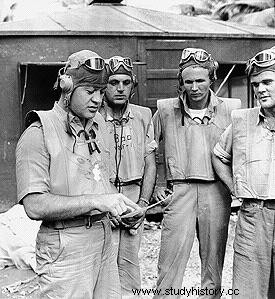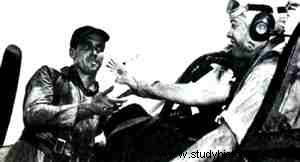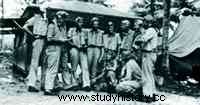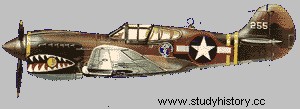(December 4, 1912 – January 11, 1988)

Victory
28
Biography

One of the most famous Marine units was VMF-214, The Black Sheep, thanks to the personality of their commanding officer, Major Gregory "pappy" Boyington. The feats of arms of the 214 were the subject of a television series broadcast in 1980:Les Têtes brûlées. If each episode was strongly fictionalized, the dogfights were very real, since they were sequences of films taken in operations.

The unit was transformed on Corsair in June 1943, when it was commanded by Major Ellis. Boyington had been credited with six victories while serving on P-40s with the Flying Tigers in China. Reintegrated into the Marines, he completed a tour of operations in 1942 without encountering a single enemy. He took command of VMF-214, while it was being reorganized after its second tour in the Solomons. The fiery Boyinglon soon put the unit back on its feet; she joined Munda (New Georgia) in mid-September, and her aggressive commander pioneered the art of raising the Japanese fighters based at Kahili and Buin (Bougainville).
The first mission was on the 16th, a bomber escort to Baliale, during which the squadron found itself in the midst of forty Japanese fighters. A Hamp flew past Boyington, flapping its wings to join the formation; the American pilot throttled up and fired a burst at him; the Japanese pilot had not been able to identify the American aircraft:this was fatal to him. Within minutes, Boyington had four more to his credit and became the first ace in a day on a Corsair.
From the first four weeks of their tour of operations on Kahili, the "hotheads" posted forty-seven confirmed victories on their list of hunts. After an escort, Boyington and his guys went to challenge the enemy at his house, as usual. Arrived on Kahili, the sky was empty when the leader heard, loud and clear, in his headphones:"Major Boyington, what is your position?" ...
But he had the advantage of altitude and position; so it only took him a few seconds to reduce the Japanese strength by three units. VMF-214 was the most successful squadron throughout September.
At the end of the month, he reached Espiritu-Santo for a well-deserved rest period. On December 17, the "Black Sheep" were again at the front, based in Vella Lavella, for their third and final round of operations. Boyington was designated as the leader of the Allied fighter attacks on Rabaul.

The massive deployment of Allied fighters of various types began with great confusion. Boyington put it right:he defined new tactics and disciplines which were tested during the two days preceding Christmas 1943.
On the 23rd, about thirty Japanese were claimed, including twelve by the VMF- 214 and four by Boyington, bringing his score to twenty-four. The VMF223, commanded by Major Marion Cari (sixteen victories), a newcomer, was integrated into the device. Cari was well placed to follow the ace of the theater that was Boyington. December 27 and 28 were particularly active days for the Marines and, to say the least, disastrous for the enemy. Boyington, who had downed a Zero, was just one win behind record holder Joe Foss and was excited to pass him. But a period of bad weather grounded the Corsairs, and the tour of operations was to end in mid-January 1944...
Although Boyington was very tired at the beginning of January, he continued his missions. (In order not to doze off in flight, he introduced fine particles of tobacco under his eyelids, which, irritating his eyes, made him keep them open.) In addition, he was pursued by war correspondents, at the search for the scoop that would sanction the new record.
The weather improved and a major mission was planned for the 3rd; it was to be led by Carl who, sportingly, withdrew in favor of Boyington. The mission to Rabaul and the planned melee took place; Early on, Boyington torched a Zero, then his wingmen lost sight of him.

He dived on the attack with Ashmun, his second, when they were assaulted by other Zeros. Both Corsairs adopted a defensive scissor flight and each downed a red disc fighter.
Ashmun was hit and his engine began to smoke; Boyington covered him on his descent to the sea and shot down another Zero as his wingman splashed down. Leaving the scene, Boyington's Corsair was hit in the tank and caught fire, but the American ace had time to parachute.
The pack of Japanese spent the next quarter of an hour strafing Boyington, held to the surface by his lifejacket. Wounded, he waited two hours before inflating his lifeboat. Shortly before nightfall, an enemy submarine surfaced and captured him.
The Japanese never reported that they had taken Boyington prisoner and he was reported missing.
Thus, the ace of aces with twenty-eight victories was awarded the Medal of Honor posthumously... before receiving it in person after his release, at the end of the war...
